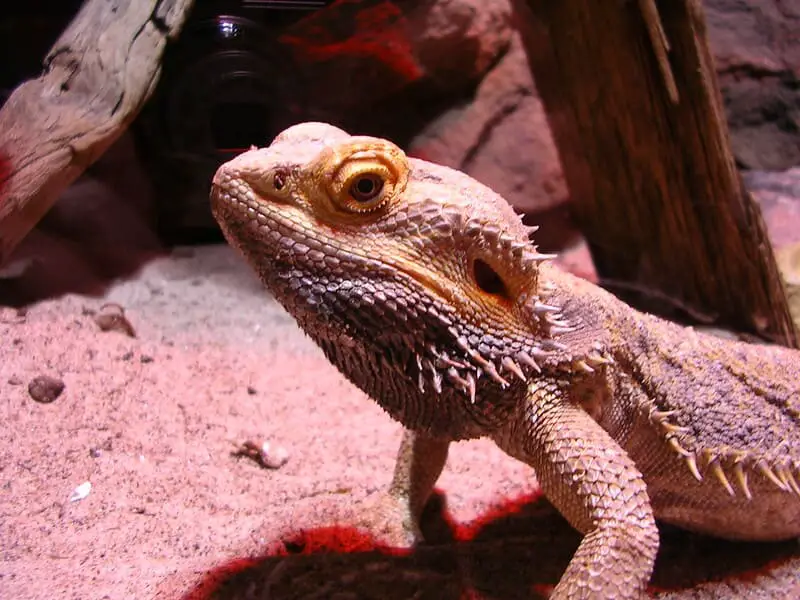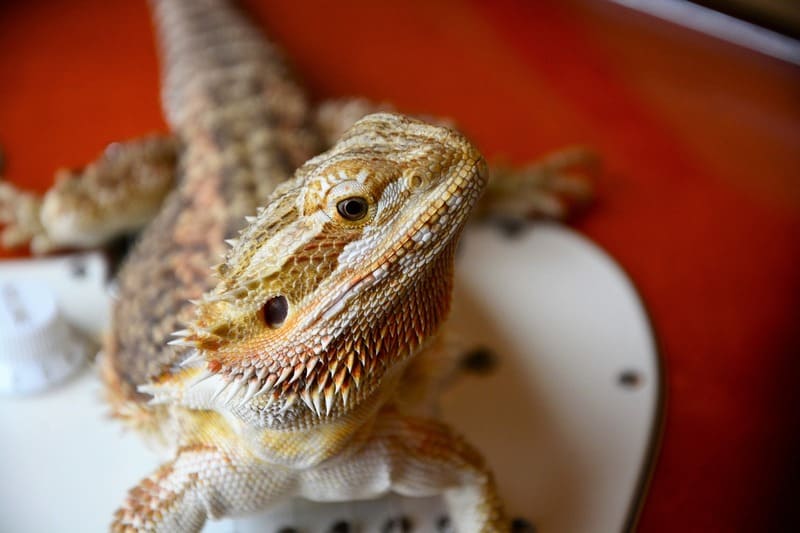Cleaning a bearded dragon’s tank is a crucial aspect of their care and overall well-being. A clean and well-maintained enclosure promotes a healthy environment for your pet and minimizes the risk of diseases. Bearded dragons are known for their docile and friendly nature, but they can be sensitive to changes in their environment. Therefore, it’s essential to establish a regular cleaning routine that ensures their habitat remains clean and safe. In this comprehensive guide, we will discuss the step-by-step process of cleaning a bearded dragon’s tank, including enclosure maintenance, sanitation, and helpful tips for a happy and healthy pet.

The Importance of a Clean Bearded Dragon Tank
Maintaining a clean and hygienic environment for your bearded dragon is vital for several reasons:
1. Health and Well-Being: A clean enclosure helps prevent the growth of harmful bacteria and parasites that can adversely affect your bearded dragon’s health. It reduces the risk of diseases and infections that can be caused by unsanitary conditions.
2. Comfort: Bearded dragons are more comfortable and less stressed in a clean and well-maintained environment. Dirty enclosures can lead to discomfort and anxiety in your pet.
3. Odor Control: Regular cleaning helps control odors that can develop in the tank due to waste, uneaten food, and other organic matter.
4. Aesthetic Appeal: A clean enclosure not only benefits your bearded dragon but also enhances the overall appearance of the habitat, making it more enjoyable to observe.
5. Behavioral Health: A clean and enriching environment can positively impact your bearded dragon’s behavior. It can encourage natural behaviors, physical activity, and mental stimulation.
To ensure that your bearded dragon remains healthy and happy, let’s explore the detailed steps involved in cleaning their enclosure.
Step-by-Step Guide to Cleaning a Bearded Dragon’s Tank
1. Gather Your Cleaning Supplies
Before you begin the cleaning process, it’s essential to gather all the necessary cleaning supplies. Here’s a list of items you will need:
Cleaning Supplies:
- Bucket
- Soft bristle brush or sponge
- Paper towels or cleaning cloths
- Scraper or spatula (for removing stuck-on waste)
- Vinegar or a reptile-safe terrarium cleaner
- Fresh substrate (if needed)
- New or cleaned decor items (if any)
- Rubber gloves (optional but recommended)
2. Remove Your Bearded Dragon
The first step in cleaning the tank is to remove your bearded dragon. It’s essential to relocate your pet to a safe and temporary enclosure during the cleaning process to prevent any stress or injury. Place them in a separate tank or secure container with adequate heating, lighting, and ventilation.
3. Clear the Tank
Start by removing all items from the tank, including decor, branches, rocks, and feeding dishes. Place these items in a separate container for cleaning. Take care when handling these items, as they may have waste or other debris on them.
4. Dispose of Excess Substrate
If your bearded dragon enclosure has a substrate, remove any excess substrate that has been soiled with waste or has become compacted. It’s a good practice to replace a portion of the substrate during each cleaning, depending on the type of substrate you use. The substrate should be replaced completely every 1-2 months.
5. Scrape and Remove Waste
Inspect the tank’s bottom for any stuck-on waste or debris. Using a scraper or spatula, gently remove any dried-on waste or uneaten food. Be careful not to scratch the glass or damage the enclosure’s surface. Dispose of the waste material in a garbage bag.
6. Clean Decor and Accessories
Thoroughly clean any decor items, feeding dishes, and accessories that were in the tank. Use warm water and a soft bristle brush or sponge. If needed, a mild vinegar solution (1 part vinegar to 3 parts water) can be used to remove stubborn residue. Rinse the items thoroughly with clean water to ensure no cleaning residue remains.
7. Clean the Enclosure
It’s time to clean the inside of the tank. Follow these steps for effective cleaning:
a. Remove Substrate: If your bearded dragon’s enclosure has a substrate, remove the remaining substrate. Wipe the tank bottom clean and inspect for any remaining waste or debris.
b. Sanitize the Tank: Prepare a cleaning solution by mixing equal parts of water and vinegar (1:1). This diluted vinegar solution is an effective and safe cleaner for reptile enclosures. Apply the solution to the tank’s interior surfaces, including the glass or plastic walls, and use a soft bristle brush or sponge to scrub away any residue. Pay particular attention to corners and crevices where waste may accumulate.
c. Rinse Thoroughly: After cleaning, rinse the tank thoroughly with clean water to remove any traces of the vinegar solution. Be sure there is no residual cleaning solution left behind, as vinegar can be harmful if ingested or inhaled by your bearded dragon.
d. Dry the Tank: Allow the tank to air dry completely before reassembling it. This helps ensure that no moisture is left in the enclosure, which can lead to bacterial growth.
8. Replace or Add Substrate
If you use a substrate in your bearded dragon’s enclosure, now is the time to replace or add it. Choose an appropriate substrate for your pet, such as reptile carpet, ceramic tiles, or a suitable loose substrate (e.g., coconut coir, cypress mulch, or paper towels). Make sure the substrate is clean and dry before placing it back into the tank.
9. Reassemble the Tank
Place all cleaned and dried decor items, branches, rocks, feeding dishes, and any other accessories back into the enclosure. Arrange them to create a stimulating and enriching environment for your bearded dragon.
10. Check and Maintain Heating and Lighting
Before returning your bearded dragon to its tank, ensure that the heating and lighting elements are functioning correctly. Check the temperature and lighting levels to maintain the appropriate conditions for your pet.
11. Return Your Bearded Dragon
Once the tank is fully reassembled, and the environment is stable, return your bearded dragon to its clean and refreshed enclosure. Be sure to handle your pet gently during this process.
12. Dispose of Waste
Dispose of the waste material, paper towels, or cleaning cloths in a sealed plastic bag and place it in the garbage. Proper disposal helps prevent any contamination or spreading of potential pathogens.
13. Routine Maintenance
Cleaning your bearded dragon’s tank is not a one-time task but a regular responsibility. Establish a cleaning schedule based on the size of the enclosure, the substrate used, and the cleanliness of your pet. Here are some additional routine maintenance tips:
a. Daily Spot Cleaning: Check the enclosure daily for waste and uneaten food. Remove any visible waste promptly to maintain a clean and odor-free environment.
b. Regular Substrate Replacement: Depending on the substrate used, replace a portion of it every 1-2 weeks to minimize the accumulation of waste. Complete substrate replacement should be done every 1-2 months.
c. Weekly Cleaning: Perform a more thorough cleaning of the enclosure on a weekly basis. Remove and clean decor items, feeding dishes, and substrate (if applicable).
d. Monthly Deep Clean: Once a month, perform a deep cleaning of the entire enclosure, following the steps outlined above. This helps prevent the buildup of harmful bacteria and keeps the habitat hygienic.
e. Health Monitoring: Regularly observe your bearded dragon’s behavior and health to detect any signs of illness or stress. A clean and well-maintained environment supports your pet’s overall well-being.

Additional Cleaning Tips and Considerations
1. Quarantine New Additions
If you plan to introduce a new bearded dragon or any other reptile to your collection, it’s crucial to quarantine the new arrival in a separate enclosure for a specific period. This quarantine helps prevent the potential spread of diseases and parasites to your existing pets. During quarantine, make sure to follow proper cleaning and hygiene practices for the new arrival’s enclosure as well.
2. Use Reptile-Safe Cleaning Products
When selecting a cleaning solution for your bearded dragon’s enclosure, it’s essential to choose reptile-safe options. Vinegar is a commonly used and safe cleaning agent when diluted with water. There are also specialized reptile terrarium cleaners available in the market, which can be used according to the manufacturer’s instructions. Avoid using harsh chemicals, bleach, or ammonia-based cleaners, as they can be harmful to your pet.
3. Minimize Stress During Cleaning
The cleaning process can be stressful for bearded dragons, as it involves handling, relocation, and changes in their environment. To minimize stress, handle your pet gently, avoid sudden movements, and provide a familiar and comfortable temporary enclosure during cleaning.
4. Prevent Cross-Contamination
To prevent the potential transmission of diseases or parasites, it’s essential to avoid cross-contamination between enclosures. Use separate cleaning equipment and tools for each enclosure, and wash your hands thoroughly after handling different reptiles.
5. Establish a Cleaning Routine
Creating a regular cleaning routine is crucial for maintaining a clean and healthy environment for your bearded dragon. Consistency in cleaning practices helps prevent the buildup of waste and keeps the enclosure hygienic.
6. Monitor Health and Behavior
In addition to routine cleaning, it’s essential to closely monitor your bearded dragon’s health and behavior. Any changes in appetite, activity level, or appearance should be investigated promptly. Regular health checkups with a reptile veterinarian can help ensure the well-being of your pet.
Conclusion
Cleaning a bearded dragon’s tank is a fundamental aspect of responsible reptile ownership. Maintaining a clean and hygienic environment promotes the health, comfort, and well-being of your pet. By following a regular cleaning schedule and taking precautions to prevent cross-contamination and stress, you can ensure that your bearded dragon enjoys a clean and enriching habitat. Remember that a clean enclosure not only benefits your pet but also enhances your own enjoyment of observing and interacting with your beloved reptile companion.
